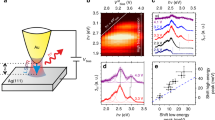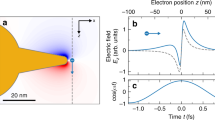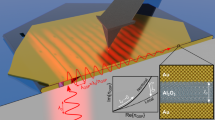Abstract
Metal nanostructures act as powerful optical antennas1,2 because collective modes of the electron fluid in the metal are excited when light strikes the surface of the nanostructure. These excitations, known as plasmons, can have evanescent electromagnetic fields that are orders of magnitude larger than the incident electromagnetic field. The largest field enhancements often occur in nanogaps between plasmonically active nanostructures3,4, but it is extremely challenging to measure the fields in such gaps directly. These enhanced fields have applications in surface-enhanced spectroscopies5,6,7, nonlinear optics1,8,9,10 and nanophotonics11,12,13,14,15. Here we show that nonlinear tunnelling conduction between gold electrodes separated by a subnanometre gap leads to optical rectification, producing a d.c. photocurrent when the gap is illuminated. Comparing this photocurrent with low-frequency conduction measurements, we determine the optical frequency voltage across the tunnelling region of the nanogap, and also the enhancement of the electric field in the tunnelling region, as a function of gap size. The measured field enhancements exceed 1,000, consistent with estimates from surface-enhanced Raman measurements16,17,18. Our results highlight the need for more realistic theoretical approaches that are able to model the electromagnetic response of metal nanostructures on scales ranging from the free-space wavelength, λ, down to ∼λ/1,000, and for experiments with new materials, different wavelengths and different incident polarizations.
This is a preview of subscription content, access via your institution
Access options
Subscribe to this journal
Receive 12 print issues and online access
$259.00 per year
only $21.58 per issue
Buy this article
- Purchase on Springer Link
- Instant access to full article PDF
Prices may be subject to local taxes which are calculated during checkout





Similar content being viewed by others
References
Mühlschlegel, P., Eisler, H., Martin, O., Hecht, B. & Pohl, D. Resonant optical antennas. Science 308, 1607–1609 (2005).
Schuck, P. J., Fromm, D. P., Sundaramurthy, A., Kino, G. S. & Moerner, W. E. Improving the mismatch between light and nanoscale objects with gold bowtie nanoantennas. Phys. Rev. Lett. 94, 017402 (2005).
Jiang, J., Bosnick, K., Maillard, M. & Brus, L. Single molecule Raman spectroscopy at the junctions of large Ag nanocrystals. J. Phys. Chem. B 107, 9964–9972 (2003).
Li, K., Stockman, M. I. & Bergman, D. J. Self-similar chain of metal nanospheres as an efficient nanolens. Phys. Rev. Lett. 91, 227402 (2003).
Otto, A., Mrozek, I., Grabhorn, H. & Akemann, W. Surface enhanced Raman scattering. J. Phys. Condens. Matter 4, 1143–1212 (1992).
Hartstein, A., Kirtley, J. R. & Tsang, J. C. Enhancement of the infrared absorption from molecular monolayers with thin metal overlayers. Phys. Rev. Lett. 45, 201–204 (1980).
Fort, E. & Gresillon, S. Surface enhanced fluorescence. J. Phys. D. 41, 013001 (2008).
Danckwerts, M. & Novotny, L. Optical frequency mixing at coupled gold nanoparticles. Phys. Rev. Lett. 98, 026104 (2007).
Bouhelier, A., Beversluis, M. R. & Novotny, L. Characterization of nanoplasmonic structures by locally excited photoluminescence. Appl. Phys. Lett. 83, 5041–5043 (2003).
Ghenuche, P., Cherukulappurath, S., Taminiau, T. H., van Hulst, N. F. & Quidant, R. Spectroscopic mode mapping of resonant plasmon nanoantennas. Phys. Rev. Lett. 101, 116805 (2008).
Akimov, A. V. et al. Generation of single optical plasmons in metallic nanowires coupled to quantum dots. Nature 450, 402–406 (2007).
Dionne, J. A., Diest, K., Sweatlock, L. A. & Atwater, H. A. PlasMOStor: a metal-oxide-Si field effect plasmonic modulator. Nano Lett. 9, 897–902 (2009).
Yu, N. et al. Plasmonic quantum cascade laser antenna. Appl. Phys. Lett. 91, 173113 (2007).
Oulton, R. F. et al. Plasmon lasers at deep subwavelength scale. Nature 461, 629–632 (2009).
Noginov, M. A. et al. Demonstration of a spaser-based nanolaser. Nature 460, 1110–1112 (2009).
Ward, D. R. et al. Electromigrated nanoscale gaps for surface-enhanced Raman spectroscopy. Nano Lett. 7, 1396–1400 (2007).
Ward, D. R. et al. Simultaneous measurements of electronic conduction and Raman response in molecular junctions. Nano Lett. 8, 919–924 (2008).
Ward, D. R., Scott, G. D., Keane, Z. K., Halas, N. J. & Natelson, D. Electronic and optical properties of electromigrated molecular junctions. J. Phys. Condens. Matter 20, 374118 (2008).
Cutler, P. H. et al. Proposed use of a scanning-tunnelling-microscope tunnel junction for the measurement of a tunnelling time. Phys. Rev. B 35, 7774–7775 (1987).
Tu, X. W., Lee, J. H. & Ho, W. Atomic-scale rectification at microwave frequency. J. Chem. Phys. 124, 021105 (2006).
Nguyen, H. Q. et al. Mechanisms of current rectification in an STM tunnel junction and the measurement of an operational tunnelling time. IEEE Trans. Elect. Dev. 36, 2671–2678 (1989).
Bragas, A. V., Landi, S. M. & Martínez, O. E. Laser field enhancement at the scanning tunnelling microscope junction measured by optical rectification. Appl. Phys. Lett. 72, 2075–2077 (1998).
Viljas, J. K. & Cuevas, J. C. Role of electronic structure in photoassisted transport through atomic-sized contacts. Phys. Rev. B 75, 075406 (2007).
Guhr, D. C. et al. Influence of laser light on electronic transport through atomic-size contacts. Phys. Rev. Lett. 99, 086801 (2007).
Ittah, N., Noy, G., Yutsis, I. & Selzer, Y. Measurement of electronic transport through 1G0 gold contacts under laser irradiation. Nano Lett. 9, 1615–1620 (2009).
Tien, P. K. & Gordon, J. P. Multiphoton process observed in the interaction of microwave fields with the tunnelling between superconductor films. Phys. Rev. 129, 647–651 (1963).
Park, H., Lim, A. K. L., Alivisatos, A. P., Park, J. & McEuen, P. L. Fabrication of metallic electrodes with nanometer separation. Appl. Phys. Lett. 75, 301–303 (1999).
Pauly, F. et al. Cluster-based density-functional approach to quantum transport through molecular and atomic contacts. New J. Phys. 10, 125019 (2008).
Zuloaga, J., Prodan, E. & Nordlander, P. Quantum description of the plasmon resonances of a nanoparticle dimer. Nano Lett. 9, 887–891 (2009).
Mao, L., Li, Z., Wu, B. & Xu, H. Effects of quantum tunnelling in metal nanogap on surface-enhanced Raman scattering. Appl. Phys. Lett. 94, 243102 (2009).
Acknowledgements
D.N. and D.R.W. acknowledge support from the Robert A. Welch Foundation (grant C-1636) and the Lockheed Martin Advanced Nanotechnology Center of Excellence at Rice (LANCER). F.H. and J.C.C. acknowledge support from the Deutsche Forschungsgemeinschaft, the Baden-Württemberg Stiftung, the European Union through the Bio-Inspired Approaches for Molecular Electronics network (grant MRTN-CT-2006-035859) and the Spanish Ministry of Science and Innovation (Ministerio de Ciencia e Innovacion) (grant FIS2008-04209). F.P. acknowledges funding from a Young Investigator Group.
Author information
Authors and Affiliations
Contributions
D.R.W. fabricated the devices, performed all measurements and analysed the data. D.N. supervised and provided continuous guidance for the experiments and the analysis. F.P., F.H. and J.C.C. carried out the theoretical modelling and DFT calculations. The bulk of the paper was written by D.R.W. and D.N. All authors discussed the results and contributed to manuscript revision.
Corresponding author
Ethics declarations
Competing interests
The authors declare no competing financial interests.
Supplementary information
Supplementary information
Supplementary information (PDF 1134 kb)
Rights and permissions
About this article
Cite this article
Ward, D., Hüser, F., Pauly, F. et al. Optical rectification and field enhancement in a plasmonic nanogap. Nature Nanotech 5, 732–736 (2010). https://doi.org/10.1038/nnano.2010.176
Received:
Accepted:
Published:
Issue Date:
DOI: https://doi.org/10.1038/nnano.2010.176
This article is cited by
-
Dynamical control of nanoscale light-matter interactions in low-dimensional quantum materials
Light: Science & Applications (2024)
-
Role of optical rectification in photon-assisted tunneling current
Communications Physics (2023)
-
Near-field and photocatalytic properties of mono- and bimetallic nanostructures monitored by nanocavity surface-enhanced Raman scattering
Nano Research (2023)
-
Plasmonic phenomena in molecular junctions: principles and applications
Nature Reviews Chemistry (2022)
-
Tunnel field-effect transistors for sensitive terahertz detection
Nature Communications (2021)



